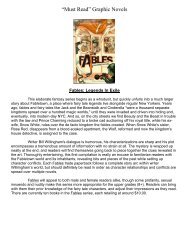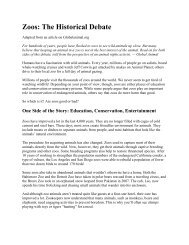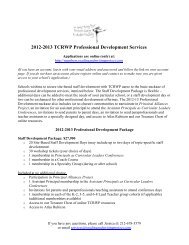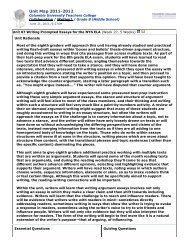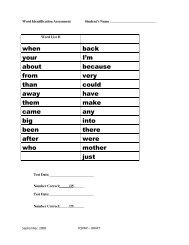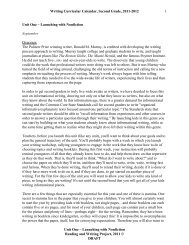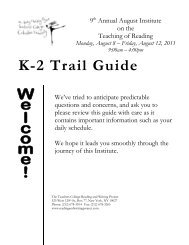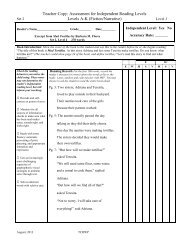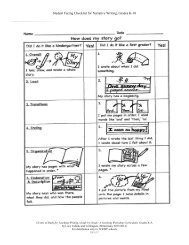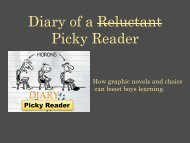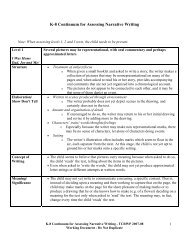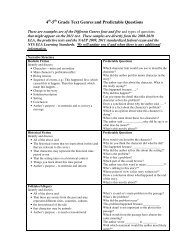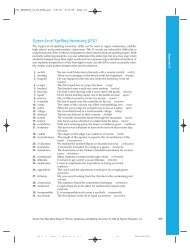Continuum for Assessing Opinion/Argument Writing - The Reading ...
Continuum for Assessing Opinion/Argument Writing - The Reading ...
Continuum for Assessing Opinion/Argument Writing - The Reading ...
Create successful ePaper yourself
Turn your PDF publications into a flip-book with our unique Google optimized e-Paper software.
to support particular points in a text. A writer might also note<br />
whether or not the in<strong>for</strong>mation comes from an expert and<br />
whether the evidence is based on the experiences of one or<br />
many people.<br />
o <strong>The</strong> writer in<strong>for</strong>mally references authors and sources used as<br />
evidence. For example, the writer might say, “ An article I<br />
read about zoos said some animals are treated poorly.”<br />
• Selectivity of in<strong>for</strong>mation<br />
o <strong>The</strong> writer analyzes sources and notes different points of view<br />
or perspectives represented. <strong>The</strong> writer seems to have selected<br />
evidence from sources that represent a point of view that<br />
supports the writer’s claim.<br />
Craft<br />
• <strong>The</strong> writer angles in<strong>for</strong>mation to support his or her argument. For<br />
example, to support the claim, dogs increase human happiness, the writer<br />
may include a story about his or her grandparents getting a dog, angling<br />
the story to show how getting a pet helped the grandparents to feel less<br />
lonely, increasing their happiness.<br />
• When including evidence from outside sources, the writer either quotes<br />
the text directly or paraphrases in detail. When the writer paraphrases,<br />
she does so by attempting to summarize key points from texts.<br />
• <strong>The</strong> writer chooses quotes that effectively support his or her claim,<br />
although they may at times be integrated clumsily. After including a<br />
quote, the writer may some explanation or description to connect the<br />
quote to the claim.<br />
• <strong>The</strong> writer may acknowledge a counter argument as a way to recognize<br />
possible opposing points of view and sway readers who might hold these<br />
points of view. If the writer does this, he or she may use transitions such<br />
as “nevertheless,” “but,” “however,” “despite this “ in order to<br />
distinguish and the counter argument from his or her claim.<br />
• <strong>The</strong> writer orders evidence not only to be logical but also to be<br />
particularly persuasive or evocative. Thinking, <strong>for</strong> instance, “How do I<br />
want to lure my reader in, and what do I want to leave her with”<br />
• <strong>The</strong>re is a sense that the writer is attempting to appeal to the reader’s<br />
emotions. To do this, the writer may insert gripping anecdotes taken<br />
from research, or may include words that evoke emotions, such as<br />
“horrifying”, “magnificent”, “cruel”, or “sickening”. <strong>The</strong> writer often<br />
does in the conclusion by calling the reader to take action or to recognize<br />
the larger significance of an issue.<br />
• <strong>The</strong> writer may use literary devices such imagery, simile, metaphor, and<br />
symbolism, albeit with some clumsiness.<br />
• <strong>The</strong> writer may use surprising, high-interest, or provocative statistics.<br />
<strong>The</strong> writer may cite specific resources <strong>for</strong> these. For example: “Did you<br />
K-8 <strong>Continuum</strong> <strong>for</strong> <strong>Assessing</strong> <strong>Opinion</strong> <strong>Writing</strong> - TCRWP 2011<br />
Working Document - Do Not Duplicate, Do Not Distribute<br />
DRAFT<br />
24



